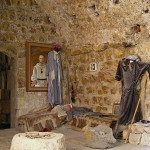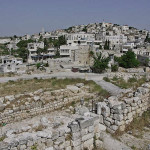Comment:
Holy Thursday, 3. Liturgy of the Eucharist, brings to the heart of the
'Holy Sacrifice of the Mass'.
Lenten Reading, or lenten browsing, on the illuminating paintings of the artist, Elizabeth Wang.Below, the twenty full colour paintings,
'Holy Sacrifice of the Mass' draw us into the wat of 'Radiant Light.
* * *
FW: Easter - Elizabeth Wang
On Friday, 11 April 2014,
William ...> wrote:
Dear Father Donald,
Thank you! - I am pleased that the Easter card and poem email reached you 'soundly', always worried lest my old version of Word causes you problems. You may judge how your encouragement to find art as a source of spiritual inspiration has excited and influenced me. I think I studied all of the available 'Emmaus' paintings before I found that particular one, the 'instant' of the revelation of Christ's presence.
Elizabeth Wang's painting are truly inspirational. I have begun saving copies of the Mass paintings to delight in them, and following your link to St Paul's, have ordered a copy of the poster. Gazing at the copies has quite entranced me. Sister Wendy's words on abstract art are profound: "We have to respond to it, be still before it, let it speak to us, before we can "see". Doesn't this parallel what happens in prayer?" and "In prayer we are still, we can allow the jumbled pattern - not to unravel into clear shapes - but to reveal in the very jumble" Our Lord's presence.
What a treasure for meditation and contemplation - thank you!
...yours in Our Lord,
William
From: Donald ...>
To: William J ...>
Sent: Thursday, 10 April 2014,
Subject: Easter approach and poem
To: William J ...>
Sent: Thursday, 10 April 2014,
Subject: Easter approach and poem
Dear William,
Thank you, and overwhelmed with your Easter gifts.
And I add to the GAZE from Elizabeth Wang's canvases.
Donald
Note:
In Elizabeth Wangs’ collage on “The Holy Sacrament of the Mass” seems to give
the key parallel to Wendy Becket’s meditation on abstract canvases.
Yet we would not know this is "two
sunflowers" had we not been given the title. The actual canvas
is an intricate mesh of colour and line: an abstraction. Given the name, we can
read it with joy. Isn't this part of the delight of the work? We have to respond
to it, be still before it, let it speak to us, before we can "see". Doesn't
this parallel what happens in prayer?
For the moment, taking Sr. Wendy latching on
to the title, it will be revealing of the rest of the 20 titles in The Holy
Sacrifice of the Mass. The GAZE on just one give me the hour before the Mass.
Poster: Holy Sacrifice of the Mass
£5.00
Quick Overview
This
beautiful poster contains twenty full-colour paintings which illustrate the
Mass from beginning to end, with English and Latin picture titles.
§
Images
and texts from this website can be downloaded for non-commercial uses, with
full attribution, under these conditions. If you copy or download images or
text from this website it is understood that you have agreed to these
conditions.
Please note these are jpeg images of
1500 pixels width. They should allow high quality printing up to size A4, and
reasonable quality printing up to size A3. You can download images one-by-one,
or use the "Download all images" button below.
THESE
DOWNLOADS ARE PROVIDED FREE OF CHARGE. PLEASE CONSIDER MAKING A DONTATION TO
SUPPORT THE WORK OF RADIANT.
http://www.radiantlight.org.uk/art_gallery/cart/
http://www.radiantlight.org.uk/art_gallery/cart/
&&&&&&&&&&&&&&&&&&&&&&&&&&&&&&&&&
1. INTROIT Entry into the Sancuary
2. KYRIE Lord Have Mercy
3. GLORIA Glory be to God
4. ALLELUIA The Gospel
5. CREDO The Creed
6. OFFERIMUS TIBI The Offertory
7. SANCTUS Holy, Holy, Holy Lord
8. EPICLESUS Come. Holy Spirit
9. HOC EST This is my Body
9. HOC EST This is my Body
11. MYSTERIUM FIDEI The Acclamation
12. OMNES QUI All our Departed
13. PER IPSUM Through Him, with Him
14. PATER NOSTER Our Father
15 AGNUS DEI Lamb of God
16. DOMINI Lord, I am not worthy
17. COMMUNIO Communion
18. LAUS ET JUBILATIO Praise and Joy
19. ITE, MISSA EST Go to Love and Serve
20. DEO GRATIAS Thanks be to God 1992
+++++++++++++++++++++++++
Sister Wendy Becket
The Gaze of Love
Meditation on Art pp.60-61
Joan Mitchell
TWO SUNFLOWERS, 1980
"Art like prayer is always the expression of longing.”
Joan Mitchell was one of the so-called second generation abstract expressionists, and the overallness of Two Sunflowers might bring Jackson Pollock to mind.
































+a.jpg)
+b.jpg)
+c.jpg)




